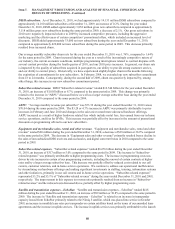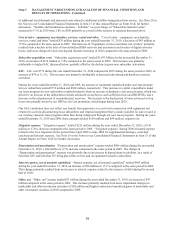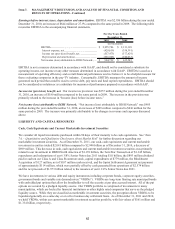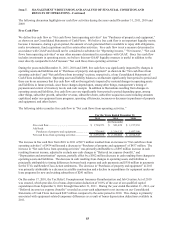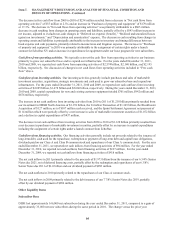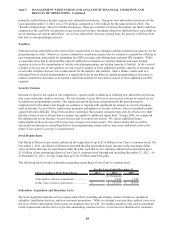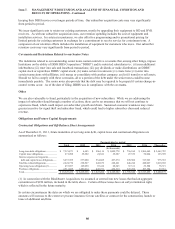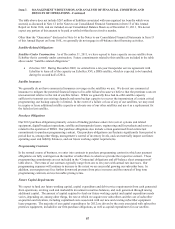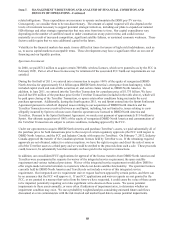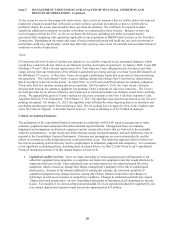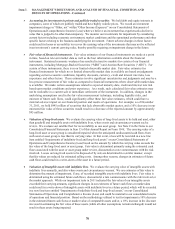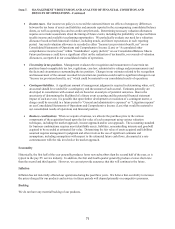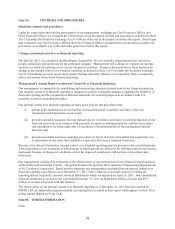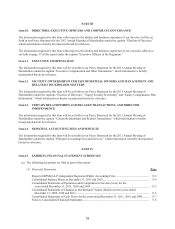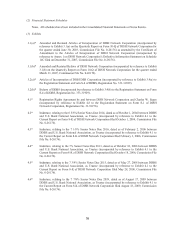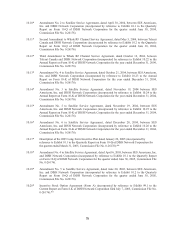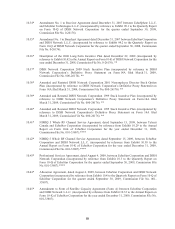Dish Network 2011 Annual Report Download - page 80
Download and view the complete annual report
Please find page 80 of the 2011 Dish Network annual report below. You can navigate through the pages in the report by either clicking on the pages listed below, or by using the keyword search tool below to find specific information within the annual report.Item 7. MANAGEMENT’S DISCUSSION AND ANALYSIS OF FINANCIAL CONDITION AND
RESULTS OF OPERATIONS - Continued
70
70
x Accounting for investments in private and publicly-traded securities. We hold debt and equity interests in
companies, some of which are publicly traded and have highly volatile prices. We record an investment
impairment charge in “Other, net” within “Other Income (Expense)” on our Consolidated Statements of
Operations and Comprehensive Income (Loss) when we believe an investment has experienced a decline in
value that is judged to be other-than-temporary. We monitor our investments for impairment by considering
current factors including economic environment, market conditions and the operational performance and other
specific factors relating to the business underlying the investment. Future adverse changes in these factors
could result in losses or an inability to recover the carrying value of the investments that may not be reflected
in an investment’s current carrying value, thereby possibly requiring an impairment charge in the future.
x Fair value of financial instruments. Fair value estimates of our financial instruments are made at a point
in time, based on relevant market data as well as the best information available about the financial
instrument. Sustained economic weakness has resulted in inactive markets for certain of our financial
instruments, including Mortgage-Backed Securities (“MBS”) and Auction Rate Securities (“ARS”). For
certain of these instruments, there is no or limited observable market data. Fair value estimates for
financial instruments for which no or limited observable market data is available are based on judgments
regarding current economic conditions, liquidity discounts, currency, credit and interest rate risks, loss
experience and other factors. These estimates involve significant uncertainties and judgments and may be a
less precise measurement of fair value as compared to financial instruments where observable market data
is available. We make certain assumptions related to expected maturity date, credit and interest rate risk
based upon market conditions and prior experience. As a result, such calculated fair value estimates may
not be realizable in a current sale or immediate settlement of the instrument. In addition, changes in the
underlying assumptions used in the fair value measurement technique, including liquidity risks, and
estimate of future cash flows, could significantly affect these fair value estimates, which could have a
material adverse impact on our financial position and results of operations. For example, as of December
31, 2011, we held $945 million of securities that lack observable market quotes, and a 10% decrease in our
estimated fair value of these securities would result in a decrease of the reported amount by approximately
$95 million.
x Valuation of long-lived assets. We evaluate the carrying value of long-lived assets to be held and used, other
than goodwill and intangible assets with indefinite lives, when events and circumstances warrant such a
review. We evaluate our satellite fleet for recoverability as one asset group. See Note 2 in the Notes to our
Consolidated Financial Statements in Item 15 of this Annual Report on Form 10-K. The carrying value of a
long-lived asset or asset group is considered impaired when the anticipated undiscounted cash flows from
such asset or asset group is less than its carrying value. In that event, a loss will be recorded in a new line
item entitled “Impairments of indefinite-lived and long-lived assets” on our Consolidated Statements of
Operations and Comprehensive Income (Loss) based on the amount by which the carrying value exceeds the
fair value of the long-lived asset or asset group. Fair value is determined primarily using the estimated cash
flows associated with the asset or asset group under review, discounted at a rate commensurate with the risk
involved. Losses on long-lived assets to be disposed of by sale are determined in a similar manner, except
that fair values are reduced for estimated selling costs. Among other reasons, changes in estimates of future
cash flows could result in a write-down of the asset in a future period.
x Valuation of intangible assets with indefinite lives. We evaluate the carrying value of intangible assets with
indefinite lives annually, and also when events and circumstances warrant. We use estimates of fair value to
determine the amount of impairment, if any, of recorded intangible assets with indefinite lives. Fair value is
determined using the estimated future cash flows, discounted at a rate commensurate with the risk involved or
the market approach. While our impairment tests in 2011 indicated the fair value of our intangible assets
exceeded their carrying amounts, significant changes in our estimates of future cash flows or market data
could result in a write-down of intangible assets with indefinite lives in a future period, which will be recorded
in a new line item entitled “Impairments of indefinite-lived and long-lived assets,” on our Consolidated
Statements of Operations and Comprehensive Income (Loss) and could be material to our consolidated results
of operations and financial position. Based on the methodology utilized to test for impairment a 10% decrease
in the estimated future cash flows or market value of comparable assets and/or, a 10% increase in the discount
rate used in estimating the fair value of these assets (while all other assumptions remain unchanged) would not
result in these assets being impaired.


